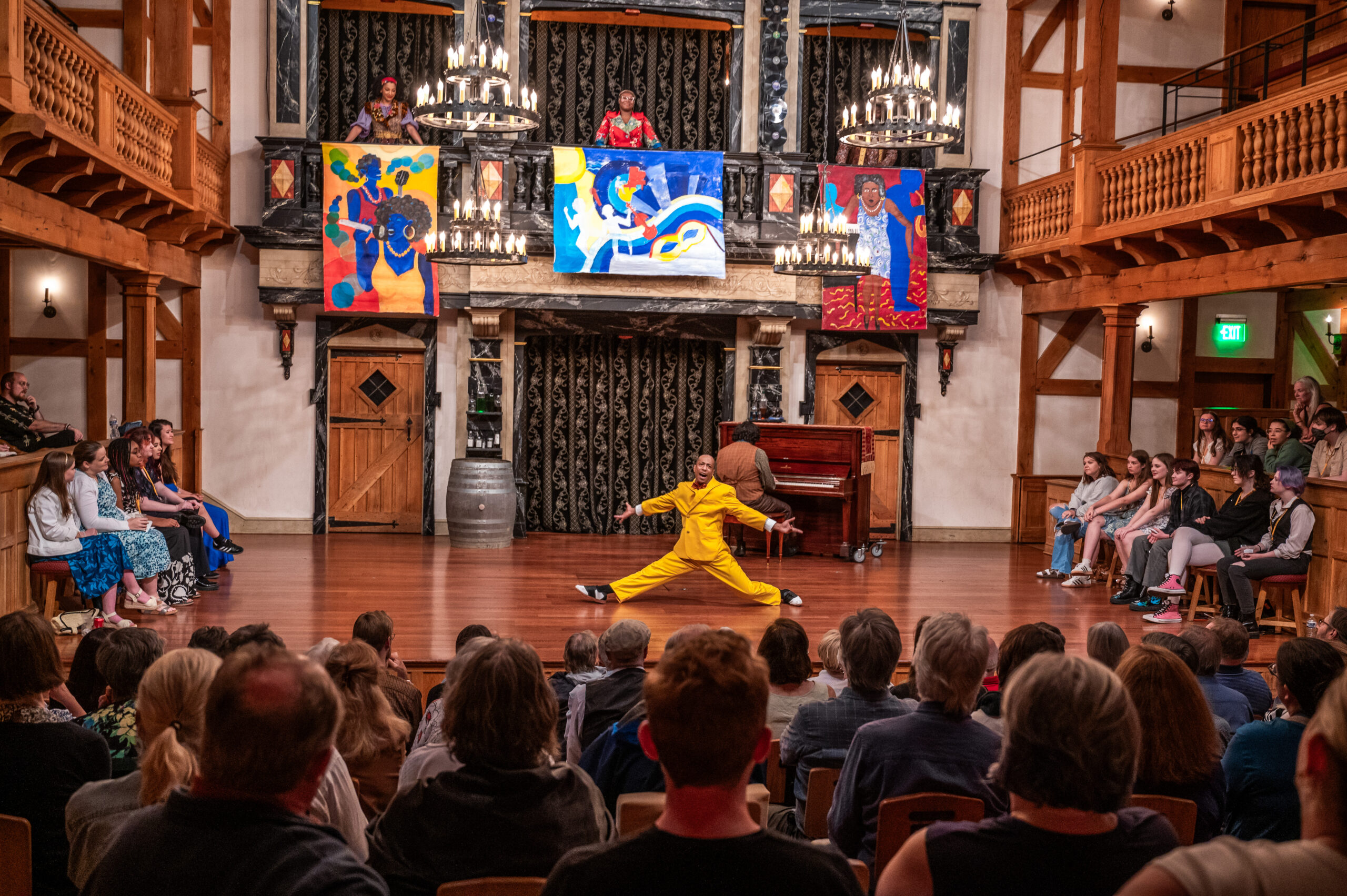American Shakespeare Center’s Blackfriars Playhouse, Through August 2
As far as Shakespeare plays go, The Winter’s Tale is stuffed full of the tropes audiences are familiar with from the Bard’s more well-tread works: jealous rage aimed at assumed infidelity, disguised identities, forbidden love, and misuse of power. But in the reliably capable hands of the cast at Staunton’s Blackfriars Playhouse, The Winter’s Tale takes on a life of its own in a manner that sets it apart. The cast breathes new life into a roughly 415-year-old work, delighting through inventive staging and top-tier acting—but why stage The Winter’s Tale during the summer season?
To be honest, I’m not sure. Ultimately, the title feels like more of a distraction than anything else. While it apparently signified to 17th-century audiences that they’d be in for a wholly unrealistic romp with a happy ending, our wintry notions of a snow-capped story shared around a fire with near-constant jingling bells is off the mark. If the cold season wasn’t the name of this play, you’d have little reason to think it wasn’t unfolding during the dog days of summer.
Free to play with the already mythical hodgepodge of political and religious references woven into the text, the nonsensical geography of Sicilia and Bohemia frees director Raphael Emmanuel to reset it in a Jazz Age milieu. Thanks to the oft-singing and instrument-playing cast, the anachronistic transplanting is a relatively seamless operation.
Kicking off with a few rounds of the late 1920s pop smash “Ain’t Misbehavin’,” a sly hint at what’s to emerge from the suspiciously minded King Leontes of Sicily, the song sets us up to watch an unsettled ruler spin out. The opening party scene descends from a protracted months-long good time into mayhem and misery.
Jordan Friend is commanding as the anguished, angry, misguided Leontes. He maintains a believability and threatening physical presence through his pacing, sizing up those he mistrusts and exploding with gut-wrenching accusations. Conversely, he shows his capacity for tender subtlety, revealed in later scenes. Also of note is his dexterity on the piano and guitar—which during one intermission stomp-along he plays simultaneously, the right hand strumming a non-fretted open chord and the left, accenting a changing figure along the keyboard behind his back. Despite this bit of ambidextrous showmanship, it’s not nearly as impressive as his skillful singing; his voice leads the cast in precision and tuneful clarity.
While the music occurs throughout—at times suspending forward plot action—this is no musical, per se. Tunes give way to Leontes’ mad accusations at both Queen Hermione (his wife), and childhood friend Polixenes, the King of Bohemia. As insecurity eats away at the Sicilian King, he jails his pregnant wife (insisting Polixenes is the father) and banishes his buddy. Tragedy is then heaped upon Leontes: His son dies unable to stomach the charges against his mother, and after giving birth to a daughter, Perdita, who Leontes wants banished, Hermoine collapses and is reported dead. Lots of poor royal decision-making hitting the proverbial fan—and all before Act IV.
Without giving away the rest of the plot, it’s worth knowing that the final two acts take place 16 years later, and offer a much different kind of play. The tragic psychological wrestling of Leontes, while looming a shadow over the resolution of the plot, are couched in comedy and executed with a markedly feel-good slant.
A reason for the changed mood can be traced to Geoffrey Warren Barnes II, the singing character of Time (in a blindingly bright, banana-yellow suit) and as pick-pocketing, wise-cracking Autolycus. In the latter role, he digs in with the spectators to wonderful results. Breaking the fourth wall repeatedly, dancing with an audience member, and even mock-stealing someone’s Diet Coke, Barnes imbues the entire second half of the play with a lightness missing from the first acts. Raven Lorraine, who is convincing as Hermione, also does double duty, stealing scenes as the loony Old Shepherd, a role reimagined for this version in a female form.
Credit is due to Emmanuel and his artistic team for the staging, which, to my memory, has made the best use of the venue I’ve ever seen. While there are many examples of the cast grappling with the walls, stairs, and aisles in ways that were new to me, a scene toward the end of Act III stands out. Angela Iannone as Antigonus recounts a dream of Hermione saying to take her baby daughter to a Bohemian beach. As Antigonus recalls the directive, the queen (Lorraine) appears overhead on the balcony and the two say the lines in an otherworldly unison.
What happens next? Look away from this spoiler, but if you’re already aware that Antigonus gets it soon after leaving the infant (as indicated by Shakespeare’s famed stage direction, “Exit, pursued by a bear”), you’ll still be pleasantly surprised by how they make the beast appear.
For what some have long considered a “problem play,” this Winter’s Tale does a more than commendable job of constructing sense, fun, and flow from a tonally uneven script. Sorry, William.
Geoffrey Warren Barnes II gives a standout performance in ASC’s summer offering of The Winter’s Tale. Supplied photo.






